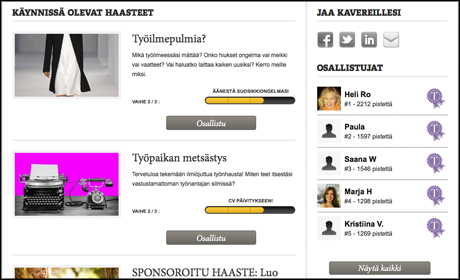
Crowdsourcing offers one effective way for magazines to engage with readers. Magazine writers may regularly communicate with their audience on social media, or perhaps invite them to submit photos or other content for possible publication.
But Bonnier Publications magazine Olivia, a Finnish title, went one step further in 2010 when it built a platform which would enable its readership to effectively build an edition of the magazine.
Speaking at magazine conference FIPP Congress in Rome today, Marjaana Toiminen, chief executive of Bonnier Publications, shared the team's experience in working with readers to create an edition of Olivia, which it has continued to do on an annual basis, with the fourth edition currently in production.
In the opening of her presentation, Toimenen advised magazine publishers to "let go" of their brand, "and give it to the audience".
The main reason being, she added, is to encourage those working on the magazine to start thinking in different ways.
"We need to let the audience change us if we want them to pay attention," she explained.We need to let the audience change us if we want them to pay attentionMarjaana Toiminen
"Journalists' minds might be set in a certain routine way. This is a way to shift their minds and open them to new ways of innovating."
The online platform created by Olivia – called Omaolivia – allows the audience to feed into decisions, such as questions to be asked, or select an image from a photo shoot.
It was first launched in 2010. Setting the scene, Toiminen highlighted the fact that at this point "Twitter was the new buzzword in journalism", with social media users "becoming primary news sources".
As such, the team at Olivia was keen to respond to this desire on the part of the audience to be more involved. The idea "was to get closer to people they already thought they knew quite well," Toiminen added.
Omaolivia sees the audience and magazine team working together "in a process that lasts for weeks". For example, the community might be asked what angle the story should focus on, with the journalist then producing the content. The audience may then be asked for input on the headline, or the 'blurb' used on the homepage.

The collaborative platform Omaolivia
Lessons learned
The experience has highlighted some interesting findings and useful lessons about the crowdsourcing process and how it can work with magazine production.
One interesting lesson was the need to offer "rewards" to encourage people to take part, and give their time. In the same way as people respond to earning badges on Foursquare, Olivia's participants can earn different "roles" – from assistant to editor-in-chief – based on how involved they are in the project.
Although the team had "tried to make it hard" in an effort limit the number of editors-in-chief, they ended up with 56, Toimenen explained. The busiest week of engagement saw the platform record 5,000 unique users, compared to 2,000 at its lowest level.
Another lesson which came out of the first crowdsourced edition, was that the audience actually wanted greater input. This was surprising and "very useful", Toiminen said.
A third interesting finding shared by Toiminen was the business-sense behind the model, both in terms of advertising opportunities and for sales of the magazine itself.
Advertisers, for example, are able to launch their own "challenges" on the platform which can then be turned into advertorials, meaning they can be involved in both production and have a presence in the end article.
For the magazine itself, the idea is also a "good sales argument", she explained. The crowdsourced product is launched annually during "slow season", and is found to "sell better than a regular issue".
It "performs well on newsstands," Toiminen added, explaining that readers who had contributed to the crowdsourced issue "felt privileged and excited" and loyalty was boosted.
In closing, while she accepted the project will not "change our destiny", the idea has served to provide great PR for the brand, enhanced engagement with readers and a useful platform for collaboration.
Free daily newsletter
If you like our news and feature articles, you can sign up to receive our free daily (Mon-Fri) email newsletter (mobile friendly).









